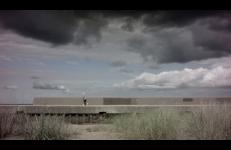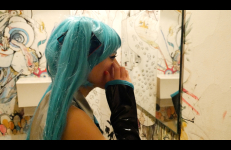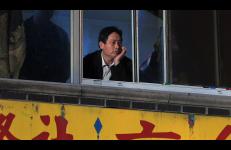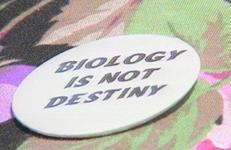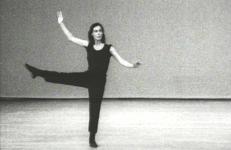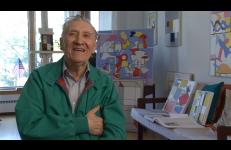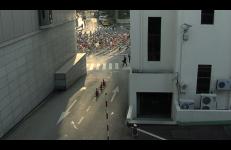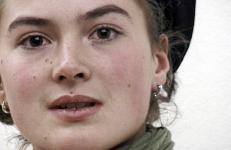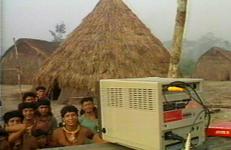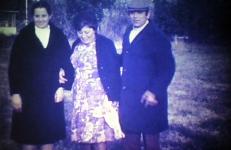The Magic Hedge explores a bird sanctuary located on a former Cold War Nike missile site on the Northside of Chicago. Left to wander and observe, the viewer becomes aware of the park's open secret: men looking for fleeting sexual contacts within the trees and shrubberies. The video highlights the many contradictions of a site historically devoted to military surveillance and now designed to preserve and control the "wildlife".
Documentary
Hatsune Miku is a co-creation platform, personified by a cute and oddly seductive animated character. Fans bring her to life by creating content that she “delivers”. Her entire persona: lyrics, music and animation – is fan created, and that's her charm. Cosplaying Hatsune Miku, Ann Oren goes to Tokyo for a performative journey among these fans and explores the Miku phenomenon as an expression of collective fantasy. The habits of Miku's fans is a familiar exaggeration of our social media habits, that flood us with crowd creativity.
A man returns, after fifty years, to Chinatown to care for his dying mother. He is a librarian, a re-cataloguer, a gay man, a watcher, an impersonator. He passes his time collecting images that he puts before us – his witnesses and collaborators. Sitting in the dark, we share his cloak of invisibility, both a benefit and a curse.
Traders Leaving the Exchange, A Guard and the Street V.1 is a 15-minute unstable remix of a video I shot in 2000, and edited in 2011, of the "members" door of the New York Stock Exchange as the traders were leaving at the end of their workday. A security guard is positioned in front of the "members" door. The shot is a close up of the door and the guard taken from across the street, busy with traffic and pedestrians.
Transexual Menace takes its title from the name of "the most exciting political action group in the USA"—transgendered people who are defining themselves, demanding their legal rights, and fighting for medical care and against job discrimination. Considered by von Praunheim to be the “most fascinating [project] in my long life as a filmmaker,” Transexual Menace is a sensitive and carefully crafted portrait that deals with issues openly and honestly. “I was able to earn the trust of many who are often reluctant to be interviewed.
Transformers: Age of Extinction, the fourth installment of the Transformers movie franchise directed by Michael Bay, was released June 27 2014. But for months ahead of the release, on YouTube one could already access an immense trove of production footage recorded by amateurs in locations where the film was shot, such as Utah, Texas, Detroit, Chicago, Hong Kong and mainland China. Transformers: the Premake turns 355 YouTube videos into a critical investigation of the global big budget film industry, amateur video making, and the political economy of images.
I worked on Trio A alone for six months in 1965. The dance consisted initially of a 5-minute sequence of movement that would eventually be presented as The Mind is a Muscle, Part I at Judson Church on January 10, 1966. There it was performed by me, David Gordon, and Steve Paxton simultaneously but not in unison. In an interim version of The Mind is a Muscle (Judson Church, May 22, 1966), it was performed by William Davis, David Gordon, and Steve Paxton. In the final section, called Lecture, Peter Saul executed a balletic solo version, i.e.
A short portrait of artist Anne Truitt (1921-2004). The film consists of an interview and 16mm footage made in and around her studio at the Yaddo artist colony, as well as footage from her home studio in Washington D.C. Rather than an attempt to depict her art, which is in many respects un-photographable, the core of the film is found in Truitt speaking about the course and meaning of her work. Says Cohen, "I was honored to know Anne Truitt, and doubly so when she allowed me to make a short record of her presence and thoughts.
tryphon: three sounds is a candid portrait of the artist Thomas H. Kapsalis (b.
Turn It On, Tune It In, Take It Over! is a portrait of freedom of expression at the dawn of the Electronic Age. The video was distilled from hundreds of hours of footage shot mostly in the early 1970s, using the first portable video format—the 1/2" open-reel, black-and-white, battery-operated, video Portapak. The piece recovers an almost lost and forgotten era of television history, when participation set out to conquer passivity, and when process was more important than product.
Produced and directed by Darlene Haber/MediaVision, executive director, Suzanne Lacy.
From a performance by Suzanne Lacy with Barbara Clausen and thirty young women from Vancouver Canada, 1997-98.
Bill Murray and Christopher Guest lead a behind-the-scenes tour of the 1976 showdown between the Dallas Cowboys and the Pittsburgh Steelers. This irreverent view of football and America's number one sports event examines the "Woodstock of corporate America" from the viewpoint of the players, the wives, the fans and the media. The big business of sports, the high stakes, the pressures, the cost in health and happiness are all covered in this kaleidoscopic view of another American ritual.
Mixing documentary reality with clever comic invention, TVTV decked itself out in tuxedos and ankle-length gowns to cover Hollywood's annual celebration. Following several nominees on the day of the event, TVTV takes the viewer behind the scenes, exposing the hazards and exhilaration of being a "star". Throughout, Lily Tomlin appears as a middle-American housewife watching the awards at home on TV, and her deadpan humor about the ephemeral nature of fame serves as a delightful counterpoint to all the serious ego-stroking going on.
Originating from personal affection toward Seoul, Twelve Scenes portrays the spectacles in daily life by juxtaposing urban space in a twelve month sequence. As the individual particles in a kaleidoscope create splendid illusions by being reflected on a mirror, Twelve Scenes shows our individual life, seemingly separated by time and space, actually composes the scenery in the kaleidoscope of Seoul. Twelve Scenes represents a 'moment for self-reflection' or 'small, but precious enlightenment on life'.
Founded in 1997, the Arab Image Foundation preserves the legacy and collection of photographer Hashem el Madani and the Sheherazade photo studio.
Three factories. Three radically different modes of production. One of the world's largest prosthetics factory, far removed in the mountains of Germany; a small haute-couture glove atelier in southern France, where each glove is made by hand; and a distressed jeans factory in central Turkey, where about 2000 pairs of jeans are produced daily, reveal paradigms of contemporary production, organization, and labor.
What do a luxury automobile, a cymbal, and a wall clock all have in common? What are the diverse attachments and experiences produced by those who make these things and those who consume them? What exchanges take place through the object itself—sensually, esthetically, abstractly? We often forget that most of the things we use are made by the labor of others, often in distant places, living dramatically different, diverse lives. What do these objects mean to them? How does their labor, their aspirations, their sense of alienation or satisfaction connect to ours?
Produced in former Yugoslavia (Bosnia-Herzegovina, Croatia, Macedonia, Serbia & Montenegro, Slovenia), Austria, USA, Canada, 1999-2003.
This observational documentary presents Venice as a city inundated with tourists as well as periodic bouts of high water. The tourists take pictures, and endure the flooded areas of Piazza San Marcos. On the canals, tourists ride in gondolas while workers collect the garbage, and others deliver building materials. In the fog we approach the Rialto Bridge and then move on towards Saluti. Here a ritual procession is in progress, an event held every year since 1643 when the plague ended.
A cross-generational binding of three filmmakers seeking alternative possibilities to the power structures they are inherently part of. Each woman extends her reach to a subject she is outside of. Vever grew out of the abandoned film projects of Maya Deren and Barbara Hammer. Shot at the furthest point of a motorcycle trip Hammer took to Guatemala in 1975, and laced through with Deren’s reflections of failure, encounter and initiation in 1950s Haiti.
A vever is a symbolic drawing used in Haitian Voodoo to invoke Loa, or god.
Video is introduced to the Enauênê Nauê Indians, a group still isolated in the North of Mato Grosso. An outgoing group, they respond with a surprising high-spirited performance that includes a good measure of clowning around and a re-enactment of an attack they suffered at the hands of their neighbors, the Cinta-Larga, not long ago. After growing accustomed to watching movies on video, they decide to produce their own.
Directed and photographed by Vincent Carelli.
In Enauenê-Nauê with English subtitles.
Video is introduced to the Enauênê Nauê Indians, a group still isolated in the North of Mato Grosso. An outgoing group, they respond with a surprising high-spirited performance that includes a good measure of clowning around and a re-enactment of an attack they suffered at the hands of their neighbors, the Cinta-Larga, not long ago. After growing accustomed to watching movies on video, they decide to produce their own.
Directed and photographed by Vincent Carelli.
In Enauenê-Nauê with English subtitles.
This video considers how Lebanese photographer Hashem el Madani captured the everyday movement of crowds, friends and family with his super 8 camera. The rushes used in the five movements of this work were shot in the late 1960s and early 1970s in tourist attractions of Egypt and Lebanon. These sites include the Beiteddine Palace, Kfarhonah, a picnic site in a pine forest in Dahr el Ramleh, and Jezzine, Madani's summer residence.
An overview of the Video in the Villages Project, this documentary shows how four different Amazonian native groups (Nambiquara, Gavião, Tikina, and Kaiapó) have embraced video and incorporated it in the service of their projects for political and ethnic affirmation.
Directed and photographed by Vincent Carelli.
An overview of the Video in the Villages Project, this documentary shows how four different Amazonian native groups (Nambiquara, Gavião, Tikina, and Kaiapó) have embraced video and incorporated it in the service of their projects for political and ethnic affirmation.
Directed and photographed by Vincent Carelli.




